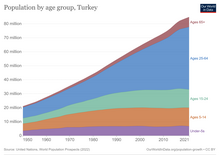The article's lead section may need to be rewritten. The reason given is: it should be a summary without so many overly precise numbers. (January 2023) |

The healthcare system in Turkey has improved in terms of health status especially after implementing the Health Transformation Program (HP) in 2003.[1] "Health for All" was the slogan for this transformation, and HP aimed to provide and finance health care efficiently, effectively, and equitably.[2] By covering most of the population, the General Health Insurance Scheme is financed by employers, employees, and government contributions through the Social Security Institution.[1] Even though HP aimed to be equitable, after 18 years of implementation, there are still disparities between the regions in Turkey. These discrepancies can be seen in terms of infant mortality between rural and urban areas and different parts of the country, although these have been declining over the years.[3] While the under-5 mortality rate in Western Marmara is 7.9, the under-5 mortality rate in Southeastern Asia is two times higher than Western Marmara, with the rate of 16.3 in 2021.[4]

In 2022, the population of Turkey calculated at more than 85 million by showing the trend in the population of old people increasing.[5] The causes of the changes between population pyramids in 2007 and 2022 are that the fertility rate decreased from 2.16 to 1.62[5][6] and the life expectancy reached 78.3 years between 2018 and 2020 in Turkey.[7]
The Human Rights Measurement Initiative[8] finds that Turkey is fulfilling 81.6% of what it should be fulfilling for the right to health based on its level of income.[9] When looking at the right to health with respect to children, Turkey achieves 95.5% of what is expected based on its current income.[9] In regards to the right to health amongst the adult population, the country achieves only 92.0% of what is expected based on the nation's level of income.[9] Turkey falls into the "very bad" category when evaluating the right to reproductive health because the nation is fulfilling only 57.3% of what the nation is expected to achieve based on the resources (income) it has available.[9]
- ^ a b Tatar, Mehtap; Mollahaliloğlu, Salih; Sahin, Bayram; Aydin, Sabahattin; Maresso, Anna; Hernández-Quevedo, Cristina (2011). "Turkey. Health system review". Health Systems in Transition. 13 (6): 1–186, xiii–xiv. ISSN 1817-6127. PMID 22455830.
- ^ Republic of Türkiye Ministry of Health. Sağlıkta Dönüşüm Programı. 2003.
- ^ Tatar, Mehtap; Mollahaliloğlu, Salih; Sahin, Bayram; Aydin, Sabahattin; Maresso, Anna; Hernández-Quevedo, Cristina (2011). "Turkey. Health system review". Health Systems in Transition. 13 (6): 1–186, xiii–xiv. ISSN 1817-6127. PMID 22455830.
- ^ Republic of Türkiye Ministry of Health General Directorate of Health Information Systems. The Ministry of Health of Türkiye Health Statistics Yearbook 2021. Ankara: Ministry of Health Publication; 2023. 274 p.
- ^ a b "Adrese Dayalı Nüfus Kayıt Sistemi Sonuçları, 2022". February 6, 2023.
- ^ "TÜİK Doğum İstatistikleri, 2022". May 5, 2023.
- ^ "TÜİK Hayat Tabloları, 2018-2020". April 26, 2023.
- ^ "Human Rights Measurement Initiative – The first global initiative to track the human rights performance of countries". humanrightsmeasurement.org. Retrieved 2022-03-13.
- ^ a b c d "Turkey - HRMI Rights Tracker". rightstracker.org. Retrieved 2022-03-13.
© MMXXIII Rich X Search. We shall prevail. All rights reserved. Rich X Search
